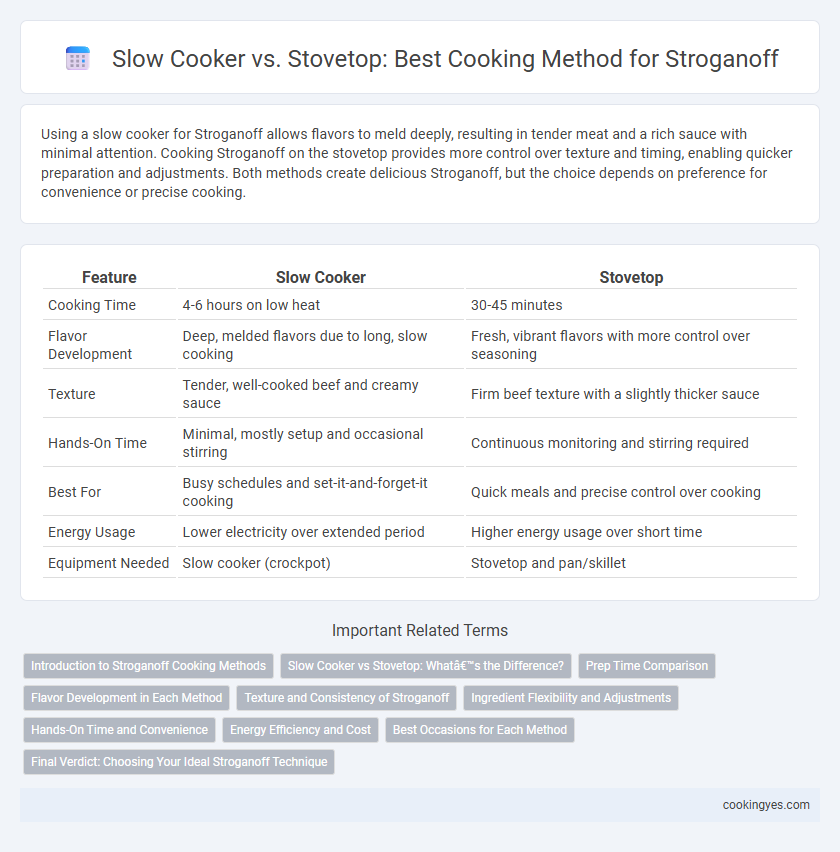Using a slow cooker for Stroganoff allows flavors to meld deeply, resulting in tender meat and a rich sauce with minimal attention. Cooking Stroganoff on the stovetop provides more control over texture and timing, enabling quicker preparation and adjustments. Both methods create delicious Stroganoff, but the choice depends on preference for convenience or precise cooking.
Table of Comparison
| Feature | Slow Cooker | Stovetop |
|---|---|---|
| Cooking Time | 4-6 hours on low heat | 30-45 minutes |
| Flavor Development | Deep, melded flavors due to long, slow cooking | Fresh, vibrant flavors with more control over seasoning |
| Texture | Tender, well-cooked beef and creamy sauce | Firm beef texture with a slightly thicker sauce |
| Hands-On Time | Minimal, mostly setup and occasional stirring | Continuous monitoring and stirring required |
| Best For | Busy schedules and set-it-and-forget-it cooking | Quick meals and precise control over cooking |
| Energy Usage | Lower electricity over extended period | Higher energy usage over short time |
| Equipment Needed | Slow cooker (crockpot) | Stovetop and pan/skillet |
Introduction to Stroganoff Cooking Methods
Stroganoff cooking methods vary primarily between slow cooker and stovetop techniques, each offering distinct advantages in flavor development and texture. Slow cookers provide even heat over extended periods, ideal for tenderizing beef and infusing rich, creamy sauces, whereas stovetop cooking allows precise temperature control and quicker preparation times. Understanding these methods enables cooks to optimize the classic Stroganoff's taste and consistency according to time and texture preferences.
Slow Cooker vs Stovetop: What’s the Difference?
Slow cooker Stroganoff offers a hands-off approach by simmering beef and mushrooms slowly, enhancing flavor and tenderness over several hours, while stovetop cooking provides quicker results with more control over texture and seasoning. Slow cooking allows connective tissues in beef to break down thoroughly at low temperatures, ideal for tougher cuts, whereas stovetop methods require vigilant timing to prevent overcooking or dryness. Choosing between slow cooker and stovetop depends on preferred cooking time, texture, and convenience for the classic Stroganoff dish.
Prep Time Comparison
Slow cooker Stroganoff requires minimal active preparation time, often around 10 to 15 minutes for searing and assembling ingredients before the slow cooking process begins, making it ideal for hands-off cooking. Stovetop Stroganoff demands more intensive prep and active cooking time, typically 30 to 45 minutes including sauteing beef and mushrooms, simmering sauce, and stirring. The slow cooker method offers a convenient, time-saving approach for busy schedules, whereas stovetop provides quicker completion but requires continuous attention.
Flavor Development in Each Method
Slow cooker Stroganoff allows flavors to meld slowly, resulting in a rich, deeply infused sauce as the beef and mushrooms tenderize over several hours. Stovetop cooking develops flavor through higher heat and faster browning, creating a more pronounced caramelization and a slightly sharper, fresher taste. Both methods enhance the classic creamy sauce, but slow cooking intensifies savory notes while stovetop preserves more texture contrast.
Texture and Consistency of Stroganoff
Slow cooker Stroganoff yields tender, melt-in-your-mouth beef with a consistently rich, velvety sauce due to prolonged low-heat cooking that allows flavors to deeply meld. Stovetop Stroganoff offers more control over texture, enabling quicker adjustments to sauce thickness and meat doneness for a firmer bite and slightly more distinct sauce consistency. Choosing between methods depends on preference for slow-derived tenderness versus rapid, customizable texture and sauce balance.
Ingredient Flexibility and Adjustments
Slow cooker cooking for Stroganoff offers greater ingredient flexibility, allowing tougher cuts of beef and root vegetables to tenderize over extended low heat, enhancing flavor depth. Stovetop methods demand precise timing to prevent overcooking delicate ingredients like mushrooms and sour cream, requiring careful adjustments to maintain texture and taste. Both methods benefit from ingredient tweaks, but slow cooking provides more forgiving adjustment timeframes for layering complex flavors.
Hands-On Time and Convenience
Slow cooker Stroganoff offers significantly reduced hands-on time, requiring only initial preparation before the appliance handles long, unattended cooking. Stovetop cooking demands more active involvement with frequent stirring and monitoring to prevent overcooking or burning. For convenience and consistent results, slow cookers provide a hassle-free option, while stovetop methods allow greater control over texture and seasoning adjustments.
Energy Efficiency and Cost
Using a slow cooker for Stroganoff typically consumes less energy compared to stovetop methods due to lower wattage and prolonged cooking times, making it more cost-effective for extended meals. Stovetop cooking, while faster, often requires higher heat levels and continuous monitoring, resulting in greater energy usage and potentially higher electricity or gas costs. Choosing a slow cooker minimizes energy waste and reduces utility bills, especially during long, low-temperature cooking sessions ideal for tender Stroganoff.
Best Occasions for Each Method
Slow cooker Stroganoff is ideal for busy weekdays or when preparing meals in advance, as it allows flavors to develop slowly over several hours with minimal supervision. Stovetop Stroganoff suits quick dinners or occasions requiring immediate serving, offering better control over texture and the ability to adjust seasoning instantly. For family gatherings or meal prep, slow cooker delivers tender meat and rich sauce, while stovetop excels in faster, freshly made portions.
Final Verdict: Choosing Your Ideal Stroganoff Technique
Slow cooker Stroganoff delivers tender, richly flavored beef with minimal hands-on time, making it ideal for busy schedules or meal prep. Stovetop cooking offers precise temperature control and faster cooking, allowing for a quicker, creamier sauce with fresher textures. Choose slow cooker for convenience and depth of flavor, or stovetop for speed and crispness when preparing classic Stroganoff.
Slow cooker vs stovetop for Stroganoff cooking method Infographic

 cookingyes.com
cookingyes.com